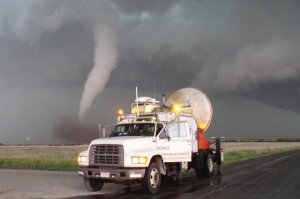 While most people run away from all types of storms, storm chasers are run toward them, and many inquire about what a storm chaser does. Storm chasing generally means pursuing any severe weather condition, regardless of the reason, such as news coverage, scientific examination, or curiosity. Storm chasers typically chase after tornados, hurricanes, and thunderstorms, according to National Geographic. Generally, storm chasers predict weather patterns and get close to storms. Some offer tours and document their experiences.
While most people run away from all types of storms, storm chasers are run toward them, and many inquire about what a storm chaser does. Storm chasing generally means pursuing any severe weather condition, regardless of the reason, such as news coverage, scientific examination, or curiosity. Storm chasers typically chase after tornados, hurricanes, and thunderstorms, according to National Geographic. Generally, storm chasers predict weather patterns and get close to storms. Some offer tours and document their experiences.
Predicting Weather Patterns
Majority of storm chasers are meteorologists who study and predict weather patterns. They forecast where and when a particular storm is likely to occur. They analyze past and current data to determine a precise location. They also use visualization by looking at the patterns of the clouds. They commonly use a variety of sources to predict weather, such as daily outlooks, satellite and radar maps, maps of temperatures and dewpoints, computer models, wind charts, and watches and warning information. Storm chasers use a variety of equipment, including computers, satellites, portable weather stations, Global Positioning Systems (GPS), video cameras, and anemometers to measure wind. Typically while in the field, storm chasers use cell phones with data connections to view the latest weather information. Depending on the area, there are certain storm chasing seasons where severe weather occurs more frequently.
Getting Close to Storms
The main task of what a storm chaser does is getting close to a storm. After careful analysis of the data, storm chasers travel to the region of where a particular storm may occur, and they constantly view the forecast throughout the expected time the storm is going to hit. They commonly arrive early to get the latest information and then wait for the storm to occur. They often work in teams with separate responsibilities, such as navigating, monitoring radios or other equipment, and observing the area. Many storm chasers are accompanied by news crews and filmmakers to capturing storms on film for later scientific, informational, or entertainment purposes. Storm chasers typically travel a great deal to follow storms. In a given day, a storm chaser could travel across numerous regions and states.
Providing Tours and Documenting Experiences
Many storm chasers take people on tours of storms and tornados to provide them with the enjoyment of watching how severe weather works. They educate tourists prior to seeing the storm to make sure they gain a better understanding of what they are viewing and to use the information in their own lives. Many companies that offer tours of storms offer them for a week to two weeks at a time. The tours commonly occur during storm seasons and the storm chasers forecast the weather patterns to get the tourists to the location where the storms are anticipated to hit. A lot of storm chasers who offer tours are responsible for travel accommodations. Storm chasers that offer tours commonly write ads and brochures to promote the tours and provide tourists with information regarding severe weather and what to expect on the tours. Storm chasers also document their storm chasing experiences through journals and publications. They write forecasts and commonly publish them on websites for other media and individuals seeking information about severe weather.
Related Resource: TSA Management Jobs
Storms are very dangerous, yet, fascinating to storm chasers. They work to gather scientific information to gain a solid understanding of how severe weather works. This is just a summary of what a storm chaser does, as specific tasks depend on location, employer, and experience.